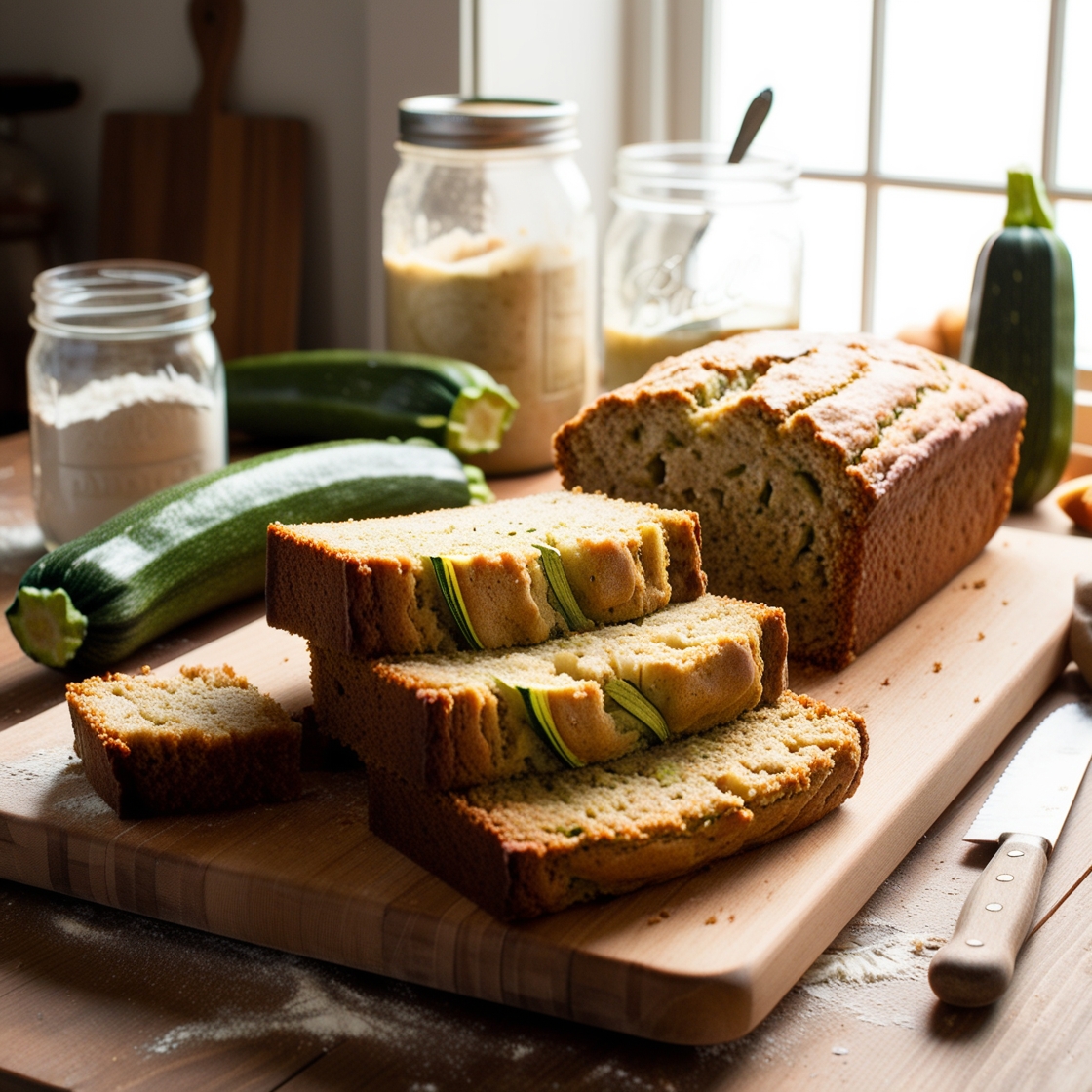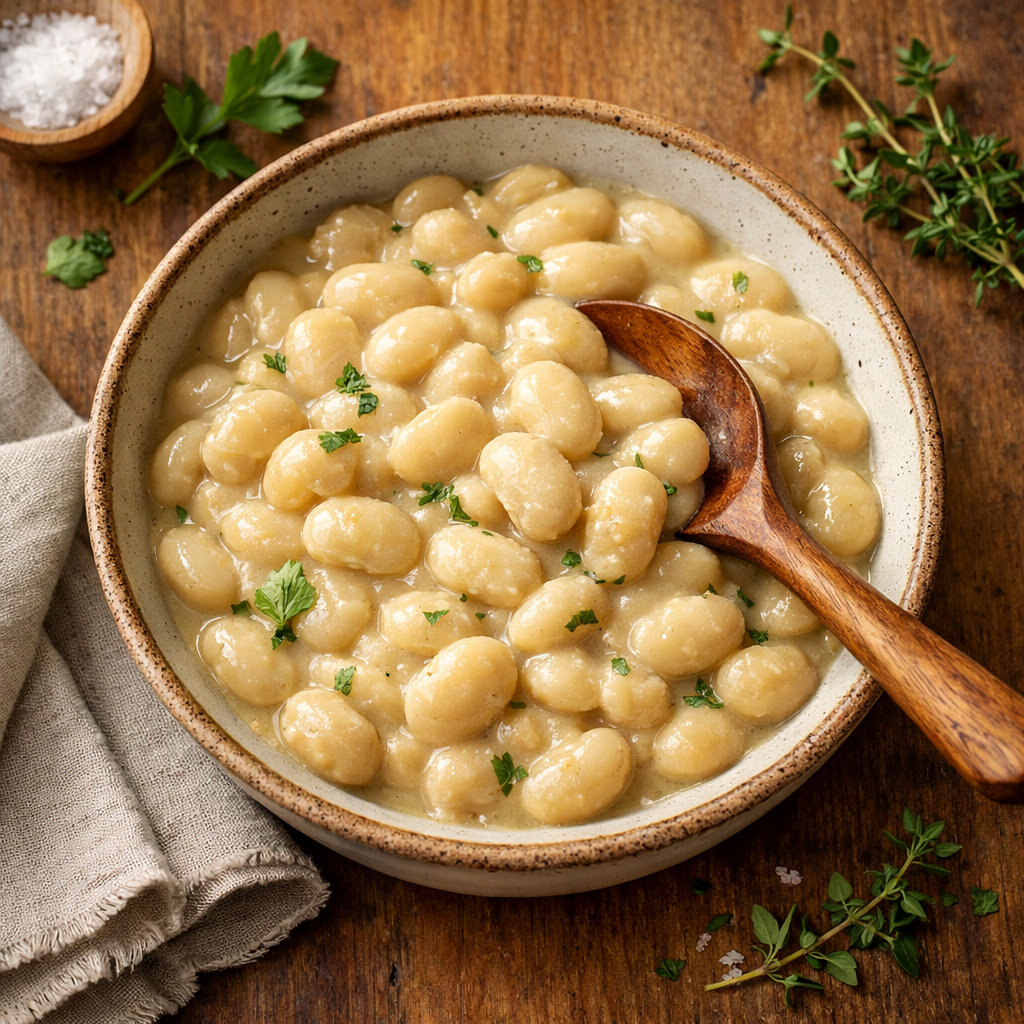That warm, yeasty aroma from my kitchen completely drew me in. I made one loaf on a lazy Saturday, and I was still thinking about it days later when the bread was completely gone. That’s when I knew I was in trouble. Now I’ve got flour under my fingernails most days. My sourdough zucchini bread came to life after a trip to the farmers market last summer—there were piles of zucchini everywhere, and I had a jar of bubbly starter just waiting to be used.
Bruce thinks I’m a little obsessed with making everything from scratch, but he doesn’t complain when there’s warm bread on the counter. Actually, he’s become my toughest taste tester. If something doesn’t pass the Bruce test, I know I need to keep working on it. He asks for this particular bread constantly – says it’s perfect with his organic chai tea and doesn’t make him feel heavy like store-bought bread does.
Rather than waste these ingredients, I decided to experiment with combining them in a bread recipe. It seemed like a logical solution to two common kitchen situations – surplus zucchini and leftover sourdough discard that would otherwise go to waste.
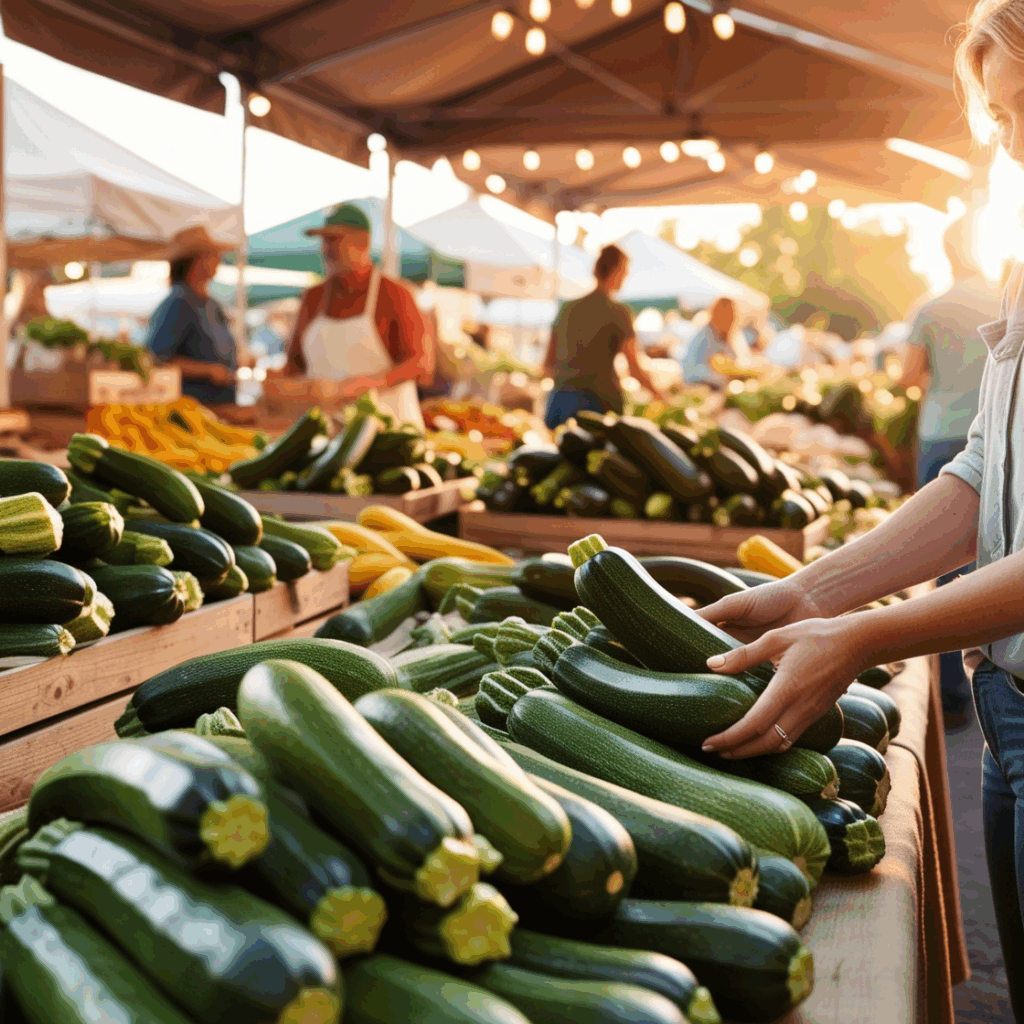
What Makes Sourdough Zucchini Bread Different
Most zucchini bread uses baking powder – mix and bake, simple. Your starter isn’t just sitting there looking pretty in the jar. It’s actually working – these tiny organisms are constantly munching on flour and emitting acids. That’s what gives you the sour punch that makes this bread special.
People say the fermentation breaks down the flour beforehand, which might explain why some people handle sourdough better than regular bread. I can’t prove it, but the difference in taste is obvious. I can’t explain the science, but the sour flavor definitely makes this bread stand out from regular versions.
I’ve served this bread to friends who usually skip bread entirely because it upsets their stomachs. Most of them can eat this without any issues. The fermentation does something to break down the flour that regular baking doesn’t accomplish.
Zucchini does more heavy lifting than you’d expect. It keeps things moist and adds vitamins and fiber. Grate it finely, mix it in, and you get soft bread that stays fresh for days. Plus, zucchini has a natural sweetness that balances out the sour notes from the starter perfectly.
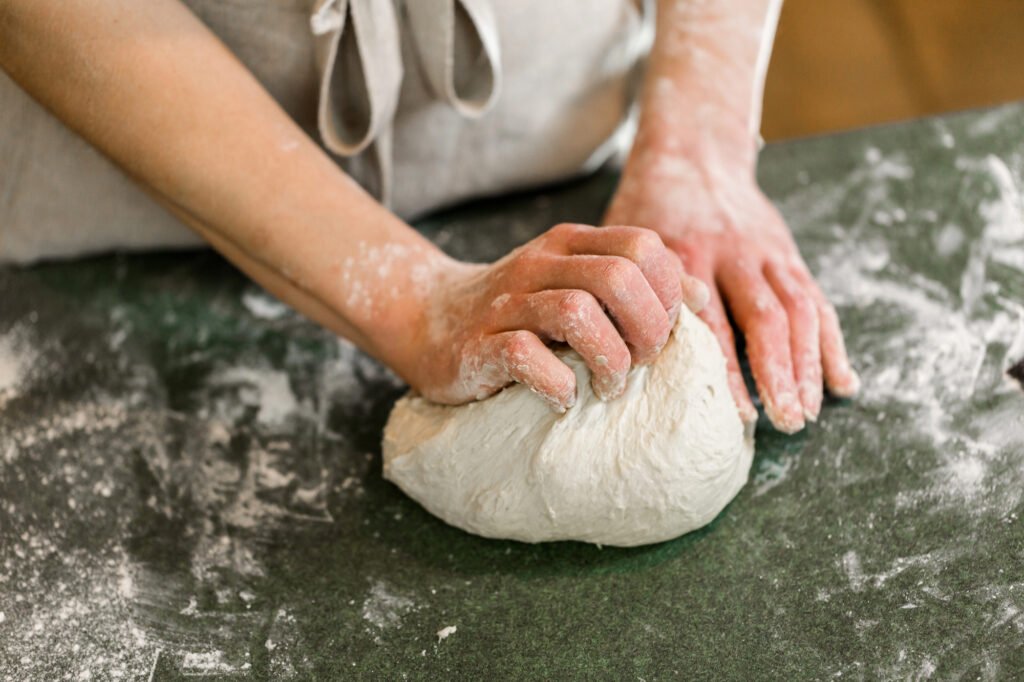
How Fermentation Transforms Your Bread
Once you mix the starter into the flour and liquid, the chemistry starts working. Wild yeast attacks the flour’s sugars, creating gas that makes the bread rise. At the same time, bacteria are busy making acids that preserve the loaf and give it that sour kick.
I’ve played around with timing quite a bit. Letting the batter sit overnight in the fridge gives you the best flavor payoff. The cold keeps everything from going overboard while the acids have time to build up properly. You end up with stronger sour notes that work really well against the zucchini’s sweetness.
The overnight method works better for my schedule too. Mix everything up after dinner, stick it in the fridge, then bake it fresh in the morning. The slow, cold process keeps you from ending up with bread that tastes like vinegar while still getting those complex flavors you want.
Picking and Preparing Your Ingredients
Good ingredients matter here. I grab zucchini that’s about six to eight inches long – not the baseball bat-sized ones that sometimes show up in gardens. The smaller ones have fewer seeds and better flesh. Look for firm skin without any mushy spots.
How you prepare the zucchini makes a big difference. I run it through the medium holes on my box grater so the pieces spread out evenly in the batter. Then comes the important part – wrapping the grated zucchini in a clean dish towel and squeezing hard to get the water out. Skip this step and you’ll have soggy bread.
The starter you use changes everything about flavor. I reach for the discard that’s been sitting in my fridge for maybe a week. It’s got character but hasn’t turned into battery acid yet. If your starter looks really watery, cut back on other liquids or your batter will be too loose.
I stick with unbleached all-purpose flour most of the time, but sometimes I’ll swap in whole wheat for half of it. The whole wheat gives you more nutrition and this nutty taste that works with zucchini. Brown sugar beats white sugar for depth, but honey or maple syrup change things up nicely too.
Pro Tip: Want zucchini prep to be smooth and satisfying? I swear by my Wüsthof Classic 8-Inch Chef’s Knife. It’s razor-sharp, perfectly balanced, and makes every slice feel effortless. Whether I’m trimming ends or slicing garden-fresh zucchinis, this knife is my secret weapon.

- KITCHEN WORKHORSE – The WÜSTHOF 8” Classic Chef’s Knife is essential for preparing any meal. This all-purpose cook’s knife can be used for chopping, mincing, slicing and dicing
- WÜSTHOF CLASSIC SERIES – The Full Tang, Triple Riveted handles of the Classic Line offer the widest range of cutlery that can satisfy every home cook or professional chef. The WÜSTHOF Classic Series has been our best-selling series for generations
- CHEF’S KNIFE – Features an 8” long blade, 5” long handle and weighs 8.5 oz. Full Bolster and Finger Guard, German Made Cook’s Knife. Ergonomic handle design made from a long-lasting synthetic material to resist fading and discoloration
- PRECISION FORGED – The 8” Chef’s Knife is forged from a single block of High Carbon Stainless Steel and tempered to 58-degree HRC. The Precision Edge Technology (PEtec) yields a blade that is 20% sharper with twice the edge retention than previous models
My Tested Recipe for Healthy Sourdough Zucchini Bread
Ingredients:
- 1 cup sourdough starter or discard (100% hydration)
- 2 cups all-purpose flour
- 1½ cups grated zucchini (about 2 medium zucchini)
- ¾ cup brown sugar
- 2 large eggs, room temperature
- ⅓ cup melted coconut oil or olive oil
- 1 teaspoon baking soda
- ½ teaspoon baking powder
- 1 teaspoon salt
- 1 teaspoon cinnamon
- ½ teaspoon nutmeg
- Optional: ½ cup chopped walnuts

How I Make It:
First thing – heat the oven to 350°F and grease up a 9×5 loaf pan. Grab a big bowl and beat together your eggs, oil, and brown sugar. Don’t go overboard here, just get everything mixed without turning it into a workout.
Dump in the sourdough starter next. Mix it until you can’t see any streaky bits. Take another bowl and whisk up all your dry ingredients – flour, baking soda, baking powder, salt, and whatever spices you’re using. Getting these mixed first means you won’t end up with pockets of baking soda.
Now fold the dry mix into the wet mixture with a rubber spatula. The key word here is fold – if you beat it too much, you’ll get bread that tastes like rubber. Once the flour disappears, add your squeezed zucchini, and nuts if you’re using them. Keep folding until everything looks even.
Scrape the batter into your pan and level off the top, and put into the oven for about an hour, maybe a bit less. Stick a toothpick in the middle – it should come out clean or with tiny wet bits stuck to it.
Let it sit in the pan for ten minutes after it comes out. This keeps it from falling apart when you flip it out onto a cooling rack. Don’t rush this part or you will have crumbs instead of slices.
Getting the Fermentation Right
This bread works both ways – fast or slow. Need bread today? Mix it up and bake it right away. You’ll get a hint of sour flavor that doesn’t fight with the zucchini taste.
Want a better flavor? Let the batter sit overnight in the fridge. I mix everything except the baking soda and powder, cover the bowl, and place it somewhere cold. Sometimes you’ll see liquid on top or the batter might look separated when you check it the next day. That’s good – it means things are working.
Before baking the overnight batter, give it a gentle stir to bring everything back together. Then add your baking soda and powder. These go in last because they lose their punch if they sit around too long in acidic batter.
The cold overnight method takes more planning but gives you deeper, more complex flavors. The acids have time to develop without going overboard.
🥄 Fermentation Hack Upgrade: Mix your batter in a JoyJolt JoyFul Glass Mixing Bowl with Lid. The airtight seal keeps your overnight ferment fresh and the clear glass lets you see those starter bubbles in action—no plastic wrap or guessing needed!

JoyJolt Kitchen Mixing Bowls. 5pc Glass Bowls with Lids Set – Neat Nesting Bowls. Large Mixing Bowl Set incl Batter Bowl, Cooking Bowls, Storage Bowls with Lids and Big Salad Bowl with BPA-Free Lids
- Durable Bowls That Nest With Ease: When it comes to glass mixing bowls, you want them sturdy, thick, clear, and space saving, right? If so, you’ll probably love these five strong mixing bowls with lids. They neatly nest with a handle on top for easy compact storage! Cook for Joy, JoyFul by JoyJolt.
- 5pc Glass Mixing Bowls With Lids Set: The big bowl is 11in wide and 5.9in tall, while the 2qt bowl is 9×3.9in. Two med / small glass bowls include 7.5×3.5in, 5.9×2.8in and finally the small glass bowl is 4.5×2.4in. Each one nests into the other with the lids on, so nothing gets lost in your cupboard.
- All Temperature Glass Mixing Bowl Set: Made from Borosilicate Glass (aka, space shuttle glass), your clear bowls are robust and love extremes! They’re Dishwasher Safe, Oven Safe to 1040DegF, Freezer Safe to minus 104DegF, and Microwave Safe containers (*NOT THE LIDS). Both lids and bowls are fridge safe.
- Air Tight Lids For Fresher Food: The airtight silicone seal and secure clips means you can use them for a food prep bowl or leftovers without odors and air getting in or out! And the large bowl lid with handle, locks securely so you can grab your nested set all at once without fumbling around.
Why This Bread Works for Your Health
This bread delivers superior nutritional value compared to commercial alternatives. Zucchini gives you vitamins C and potassium along with fiber, but it won’t pack on calories. People say fermentation makes these nutrients easier for your body to absorb.
Sourdough acids may slow down how your body handles carbs, and it may help with blood sugar spikes, but it’s always best to consult a medical professional.
The live cultures break down some of the flour before you eat it which could be why people who normally skip bread can handle sourdough without stomach issues.
If you use some whole wheat flour, you will added B vitamins, iron, and magnesium included. Since zucchini tastes sweet on its own, I don’t have to add nearly as much sugar as those factory-made loaves contain. The end result is more nutrients and your stomach handles it better than most store-bought bread.
Keeping It Fresh and How to Serve It
This bread stays good for several days if you store it right. I wrap the cooled loaf in plastic or stick it in a container with a tight lid. The acids from fermentation work like natural preservatives, so it keeps about four days on the counter.
Need it to last longer? Put it in the fridge, but expect it to get a bit dry. Toasting brings back the moisture and actually makes it taste better. I usually slice the whole thing and wrap individual pieces in plastic, then foil, before freezing. Those frozen slices last three months and go straight into the toaster.
My favorite way to eat this is toasted with butter in the morning. You get that crispy outside against the soft inside, plus the sour tang works great with coffee. For snacks, I spread cream cheese or almond butter on slices. Both pair well with the zucchini flavor.
Add-Ins That Actually Work
This recipe handles add-ins pretty well. Chocolate chips turn it into dessert territory – my children love it, and other adults pretend they’re eating healthy. I add about half a cup with the zucchini.
Raw nuts give you crunch and good fats. Walnuts are the standard choice, but pecans, almonds, or sunflower seeds all do the job. I toast them first in a dry pan for a minute or two which brings out more flavor and keeps them from getting soggy.
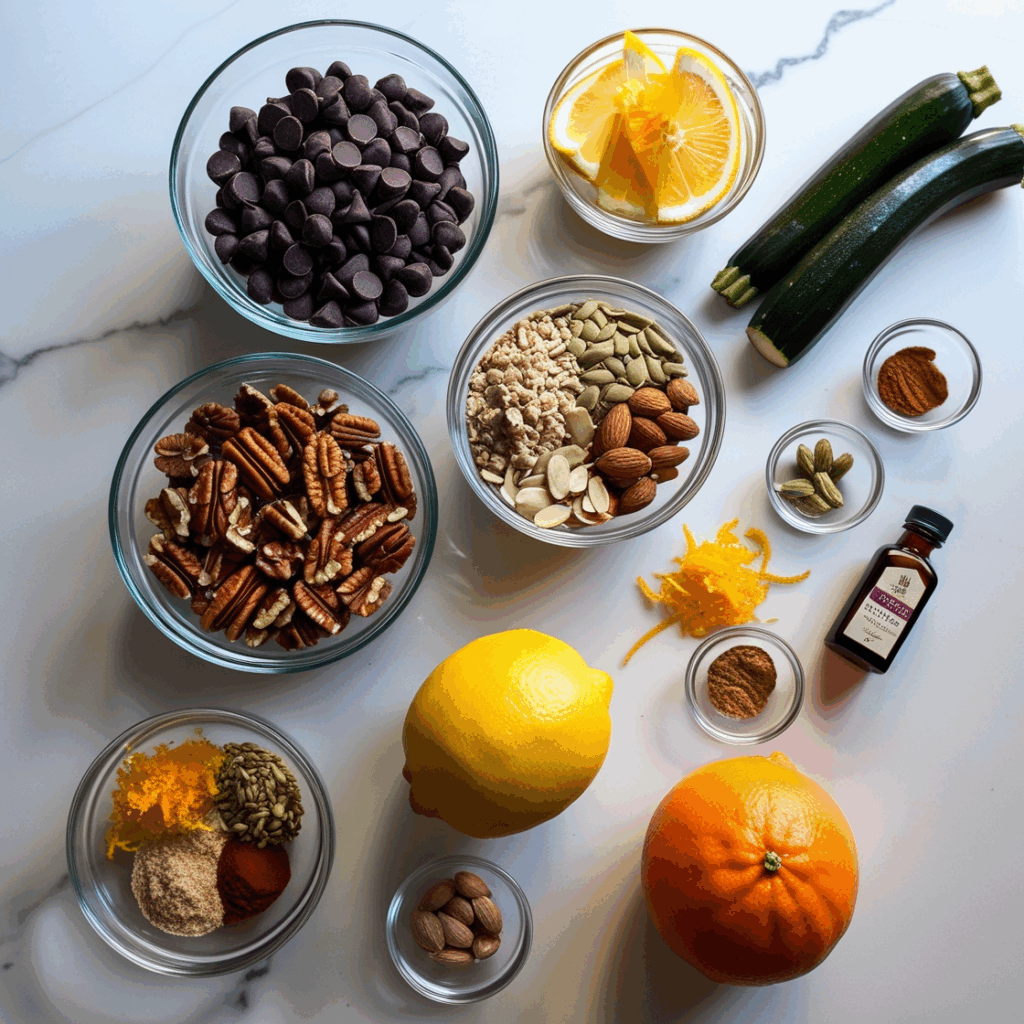
Citrus zest brightens everything up. One lemon or orange worth of zest mixed into the batter cuts through the richness nicely. The sharp citrus plays well against both the zucchini and the sour starter.
You can experiment with spices too. Cinnamon and nutmeg are safe bets, but cardamom, ginger, or allspice work if you want something different. A splash of vanilla or almond extract changes the whole flavor direction without much effort.
When Things Go Wrong
Heavy, dense bread? You probably beat the batter too hard or didn’t squeeze enough water out of the zucchini. I barely mix once the flour goes in – just until everything looks combined. And that zucchini needs to be squeezed out like a wet dishrag in a clean towel.
Soggy, wet bread means water got where it shouldn’t. Either the zucchini wasn’t drained enough or your starter is too runny. Some starters get really loose, especially in warm weather. Cut back on other wet ingredients if yours looks like pancake batter.
Bread that’s burnt on top but raw in the middle? Your oven’s running hot or has weird temperature spots. Get an oven thermometer – most ovens lie about their temperature. I also turn the pan around halfway through baking so it cooks evenly. If the top starts browning too fast, throw some foil over it.
Temperature and Timing Considerations
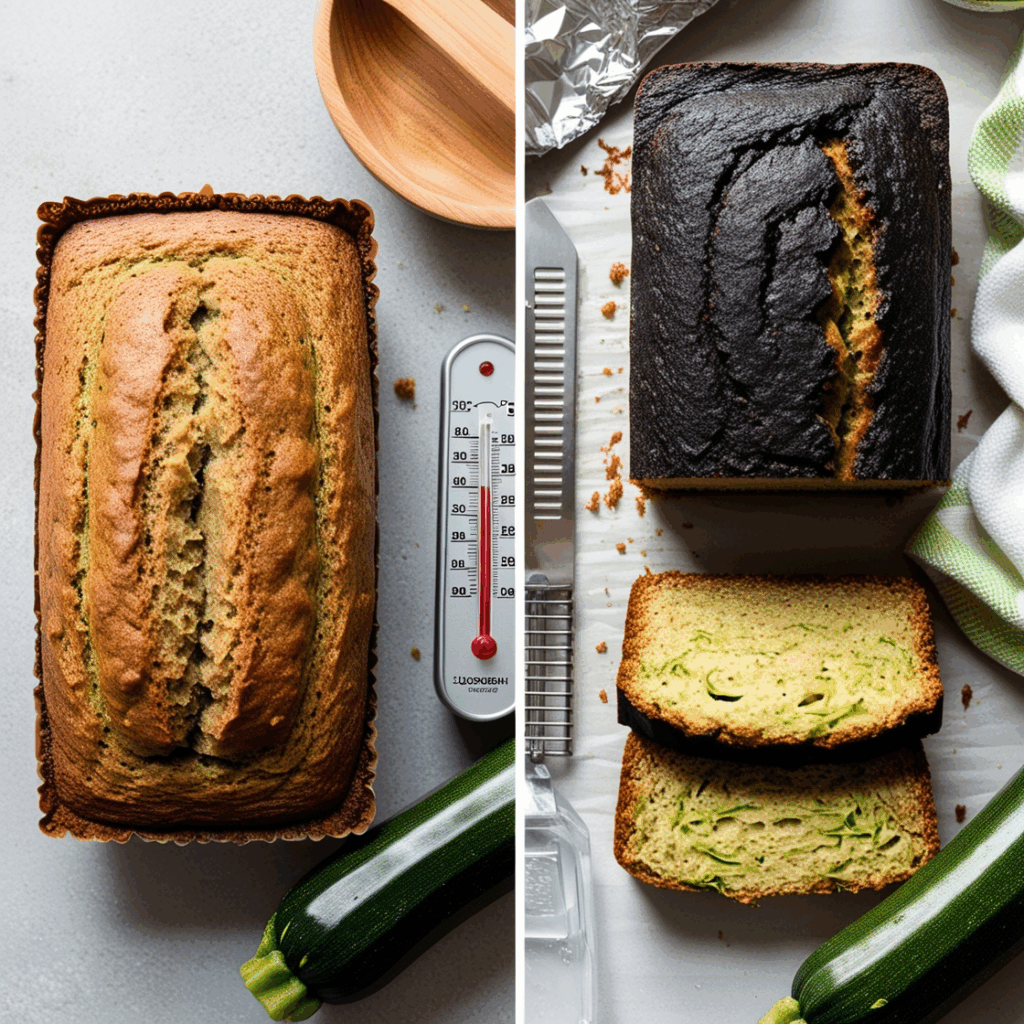
Oven temperature significantly affects both rise and texture. I always preheat thoroughly, allowing fifteen minutes for the oven to reach the correct temperature. The bread should bake in the center of the oven for even heat distribution.
Internal temperature provides the most accurate doneness test. Finished bread should reach 190°F in the center. While the toothpick test works well, a digital thermometer eliminates guesswork.
Cooling time is equally important. I resist the temptation to slice the bread immediately, as this can result in a gummy texture. Ten minutes in the pan followed by complete cooling on a wire rack ensures the best texture.
🌡️ No More Guesswork: I don’t bake bread without my ThermoPro Digital Thermometer anymore. Instead of poking it with a toothpick and crossing my fingers, I just check that the center hits 190°F. It’s quick, accurate, and takes the stress out of baking every single time.

ThermoPro TP605 Instant Read Meat Thermometer Digital for Cooking, Waterproof Food Thermometer with Backlight & Calibration, Digital Probe Cooking Thermometer for Kitchen, Outdoor Grilling and BBQ
- WATER-RESISTANT | Digital meat thermometer for cooking of any kind is water-resistant IPX6-rated and can be washed and cleaned under running water
- LARGER SCREEN | 1.6” Large food thermometer dial with bright backlight means you can always read the temperature, whether you are grilling in the dark or baking in your kitchen
- INSTANT READ & CALIBRATION | Instant read meat thermometer features advanced, highly accurate technology with 2-3 seconds response time; Comes pre-calibrated for your convenience, and recalibrating feature if needed
- MULTI-USE | Wide measuring range (-58°F to 572°F) of the cooking thermometer for meat is perfect for meats, liquids, deep frying, candy making and more; Directly turns on/off the grill thermometer by opening/closing the temperature probe, simply get the temperature result at any moment
Why This Recipe Actually Works
This bread solves a real problem – how do you make something healthy that people actually want to eat? I’ve watched my family devour loaves of this while thinking they’re getting a treat. Meanwhile, I’m happy knowing they’re enjoying something I made from scratch with wholesome ingredients.
Making bread by hand feels different than opening a package. Your kitchen smells like a bakery. You get flour on your counters and dough under your fingernails. That’s real cooking, not just reheating something from a factory.
Bruce keeps asking me to make this bread because it tastes so much nicer than store-bought loaves do. The zucchini keeps it moist for days, and the sourdough tang makes it interesting enough that he doesn’t miss regular sandwich bread.
I’ve been making this same recipe for months now, tweaking little things each time… more zucchini when the garden’s producing a lot, and including different nuts depending on what’s in the pantry. Each loaf teaches me something new about how the ingredients work together.
Give this recipe a go and let me know what happens. Tell me about your first attempt – did you squeeze the zucchini dry enough? How did your family react? I’m always curious to hear how other people’s kitchens handle this bread.
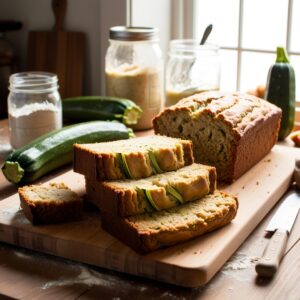
*We may earn a commission for purchases made using our links. Please see our disclosure to learn more.

